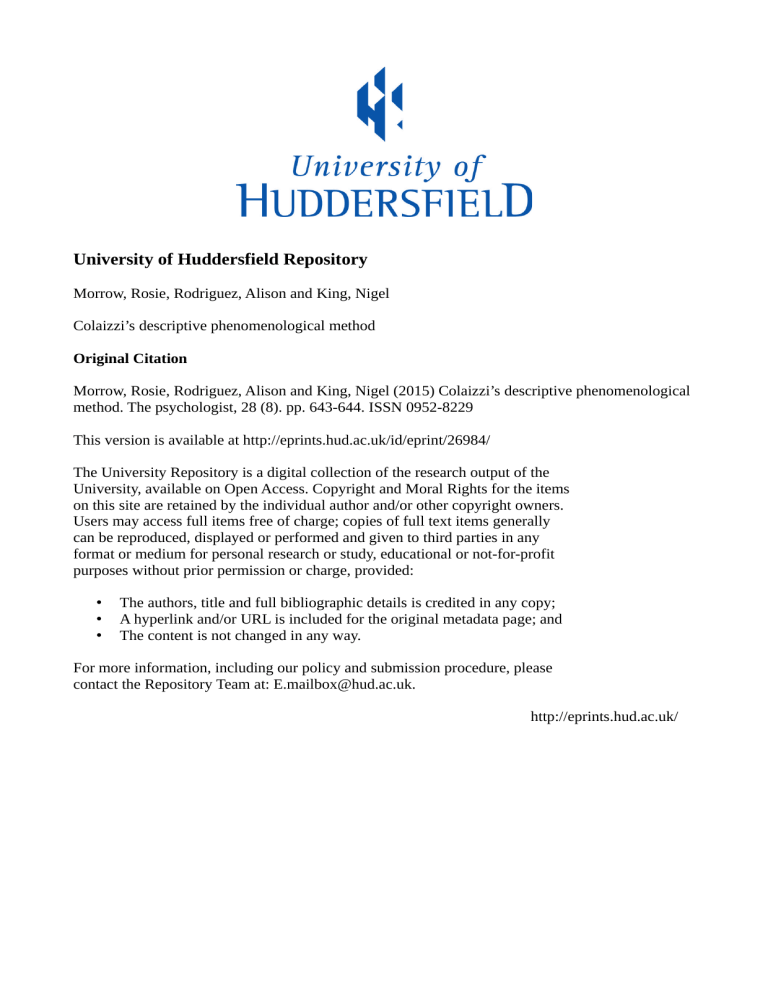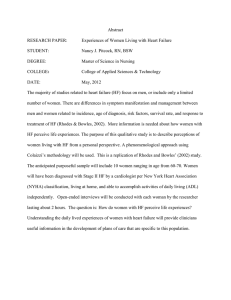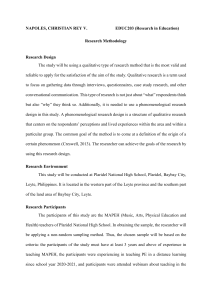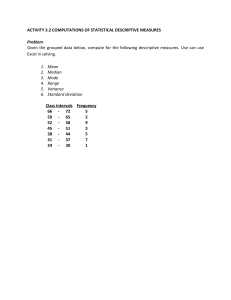
University of Huddersfield Repository Morrow, Rosie, Rodriguez, Alison and King, Nigel Colaizzi’s descriptive phenomenological method Original Citation Morrow, Rosie, Rodriguez, Alison and King, Nigel (2015) Colaizzi’s descriptive phenomenological method. The psychologist, 28 (8). pp. 643-644. ISSN 0952-8229 This version is available at http://eprints.hud.ac.uk/id/eprint/26984/ The University Repository is a digital collection of the research output of the University, available on Open Access. Copyright and Moral Rights for the items on this site are retained by the individual author and/or other copyright owners. Users may access full items free of charge; copies of full text items generally can be reproduced, displayed or performed and given to third parties in any format or medium for personal research or study, educational or not-for-profit purposes without prior permission or charge, provided: • • • The authors, title and full bibliographic details is credited in any copy; A hyperlink and/or URL is included for the original metadata page; and The content is not changed in any way. For more information, including our policy and submission procedure, please contact the Repository Team at: E.mailbox@hud.ac.uk. http://eprints.hud.ac.uk/ From “Learning from the ‘lifeworld’”. Published in The Psychologist, August 2015. Please cite as follows: - Morrow, R., Rodriguez, A. and King, N. (2015). Colaizzi’s descriptive phenomenological method. The Psychologist, 28(8), 643-644. Colaizzi’s descriptive phenomenological method Rosie Morrow (Postgraduate Student, University of Huddersfield) Alison Rodriguez (Senior Lecturer, University of Huddersfield) and Nigel King (Professor, University of Huddersfield) Descriptive phenomenology is concerned with revealing the “essence” or “essential structure” of any phenomenon under investigation – that is, those features that make it what it is, rather than something else. By far the best known descriptive approach in psychology is that of Amedeo Giorgi (1985), who is widely credited as a pioneer in bringing phenomenological thinking into psychology. Giorgi’s method can be seen as a form of distillation, in which the analyst step by step sifts away everything that is not essential to an adequate description of the phenomenon. It is, however, not the only descriptive phenomenological method in the social and human sciences. We focus here on a method proposed by Colaizzi (1978), which is little-known in psychology but widely used in other disciplines such as the health sciences. We argue that the method has considerable potential for qualitative psychologists, especially those coming fresh to descriptive phenomenology. Colaizzi’s (1978) distinctive seven step process provides a rigorous analysis, with each step staying close to the data . The end result is a concise yet all-encompassing description of the phenomenon under study, validated by the participants that created it. The method depends upon rich first-person accounts of experience; these may come from face-to-face interviews, but can also be obtained in multiple other ways; written narratives, blogs, research diaries, online interviews and so on. The stages are illustrated in the table below: From “Learning from the ‘lifeworld’”. Published in The Psychologist, August 2015. Table 1. Steps in Colaizzi’s descriptive phenomenological method Step 1. Familiarisation 2. Identifying significant statements 3. Formulating meanings 4. Clustering themes 5. Developing an exhaustive description 6. Producing the fundamental structure 7. Seeking verification of the fundamental structure Description The researcher familiarises him or herself with the data, by reading through all the participant accounts several times The researcher identifies all statements in the accounts that are of direct relevance to the phenomenon under investigation The researcher identifies meanings relevant to the phenomenon that arise from a careful consideration of the significant statements. The researcher must reflexively “bracket” his or her pre-suppositions to stick closely to the phenomenon as experienced (though Colaizzi recognises that complete bracketing is never possible). The researcher clusters the identified meanings into themes that are common across all accounts. Again bracketing of pre-suppositions is crucial, especially to avoid any potential influence of existing theory. The researcher writes a full and inclusive description of the phenomenon, incorporating all the themes produced at step 4. The researcher condenses the exhaustive description down to a short, dense statement that captures just those aspects deemed to be essential to the structure of the phenomenon. The researcher returns the fundamental structure statement to all participants (or sometimes a subsample in larger studies) to ask whether it captures their experience. He or she may go back and modify earlier steps in the analysis in the light of this feedback. From “Learning from the ‘lifeworld’”. Published in The Psychologist, August 2015. Morrow (2014) used Colaizzi’s method to explore the lived experience of camping, with a particular interest in its impact on relationships. While there is a substantial literature on the use of structured camping-based interventions as a form of therapeutic intervention (e.g. Desai, Sutton, Staley & Hannon, 2013), there is very little about how people experience everyday unstructured recreational camping. Four participants were recruited on the basis that they had recently embarked on an unstructured camping trip. Through using Colaizzi’s method, five themes were identified: ‘Getting away’, ‘relationship maintenance’, ‘tranquillity and relaxation’, ‘appreciation of the natural environment’ and ‘freedom and adventure/exploration’. Following the seven step process, an exhaustive description was created, which was then condensed into a fundamental structure of the lived experience of camping, which we reproduce below: ‘Camping provides the ideal escape for friends and couples alike. The tranquil and relaxing environment provides the ideal setting for relationship maintenance and reinforcement with friends and partners, whether there are issues to resolve or otherwise. The freedom experienced by individuals encouraged adventure and exploration, which in turn allowed them to appreciate the natural environment.’. (Morrow, 2013:49). While the fundamental structure is the end-point of the analytic process, the main themes from which it is derived are themselves useful to explore and present. Thus in Morrow, Rodriguez and King (2014) we focused particularly on the theme of “relationship maintenance”. The final step in Colaizzi’s method, returning the results to the participants, is a controversial one, criticised by Giorgi (2006) who stated that the researcher and participant inevitably have different perspectives - the researcher from a phenomenological perspective and the participant from the ‘natural attitude’ (our everyday taken-for-granted perception of the world). This echoes a wider debate in qualitative research as to the value of “respondent validation” or “member checking”. We would certainly agree that any notion that participants can simply rubber-stamp an analysis as “correct” is untenable. Nevertheless, given the aims of descriptive phenomenology, it is not unreasonable to expect that they should be able to recognise their own experience in the fundamental structure. From “Learning from the ‘lifeworld’”. Published in The Psychologist, August 2015. Descriptive phenomenology is especially valuable in areas where there is little existing research, as was the case in the example we have given of the experience of recreational camping. For psychologists, Colaizzi’s method offers a clear and systematic approach; its thematic nature may be more familiar and accessible than the “distilling” style offered by Giorgi. From “Learning from the ‘lifeworld’”. Published in The Psychologist, August 2015. References Colaizzi, P. (1978). Psychological research as a phenomenologist views it. In: Valle, R. S. & King, M. (1978). Existential Phenomenological Alternatives for Psychology. Open University Press: New York. Dessai, P., Sutton, L., Staley, M., & Hannon, D. (2013). A qualitative study exploring the psychosocial value of weekend camping experiences for children and adolescents with complex heart defects. Child: Care, Health and Development, 40(4), 553-561. Giorgi, A. (ed.) (1985). Phenomenology and Psychological Research. Pittsburgh, PA: Duquesne University Press. Giorgi, A. (2006). Concerning variations in the application of the phenomenological method. The Humanistic Psychologist. 34(4), 305–319. Morrow, R., Rodriguez, Al., & King, N. (2014). Camping: A tool for relationship maintenance? International Journal of Therapeutic Communities, 35(2), 48-55. Morrow, R (2013) A study to explore the lived experience of camping and associated effects of escapism: A green exercise approach. Masters thesis, University of Huddersfield.Available at: http://eprints.hud.ac.uk/20328/1/rmorrowfinalthesis.pdf



